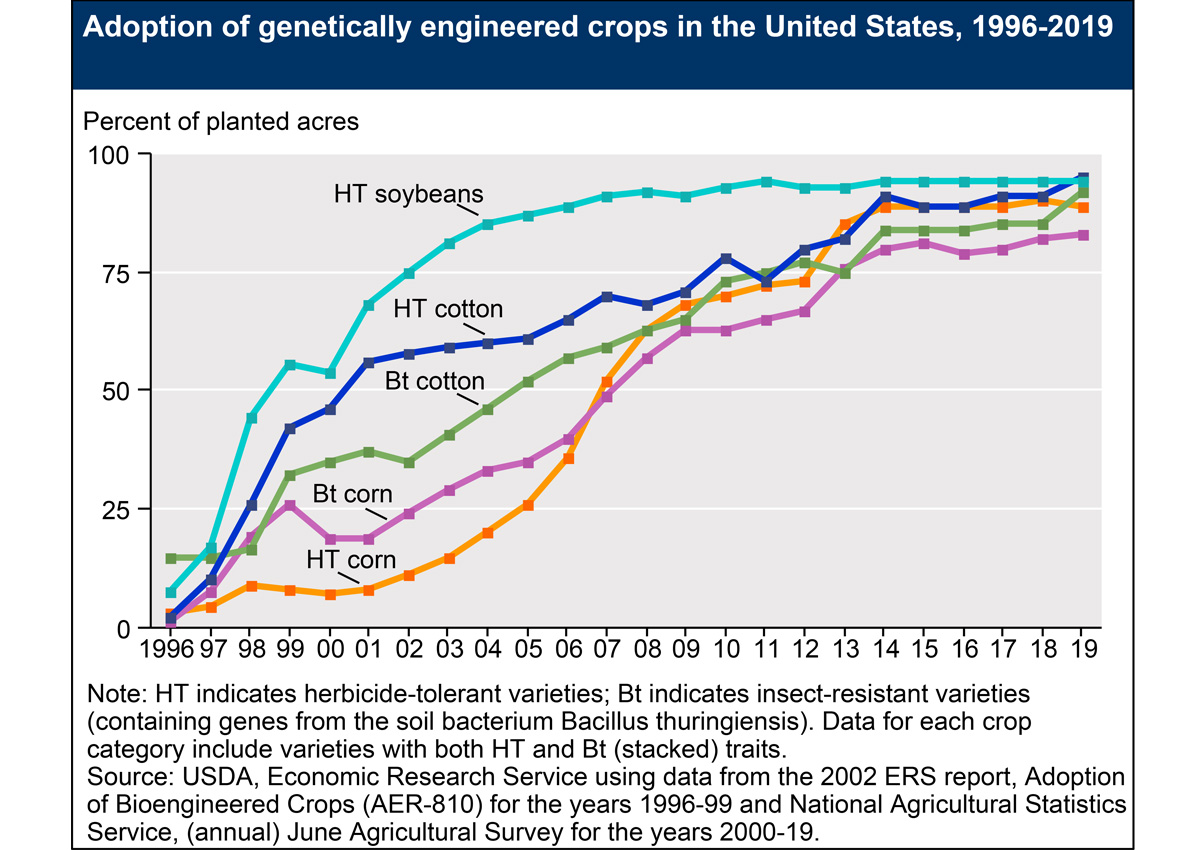
92% Cotton, 90% Corn Areas in the US Produced with GE Seeds
July 8, 2020| |
The United States is the top biotech-crop growing country in the world, having commercialized biotech crops in 1996. The adoption of stacked varieties in the U.S. has accelerated in recent years. Approximately 89% of the cotton area and 80% of corn were planted with stacked seeds in 2019. This is according to the Adoption of Genetically Engineered Crops in the U.S. published by the Department of Agriculture Economic Research Service (USDA-ERS).
Herbicide tolerant (HT) crops, which tolerate potent herbicides provide farmers with a broad variety of options for effective weed control. HT crops have been adopted in the U.S. since 1996. HT soybeans rose from 17% in 1997 to 68% in 2001, before plateauing at 94% in 2014. HT cotton area expanded from approximately 10% in 1997 to 56% in 2001, and reached a high of 95% in 2019. HT corn adoption rates increased following the turn of the century. Currently, approximately 90 percent of the domestic corn area in the U.S. is produced with HT seeds.
Insect resistant crops that contain genes from the soil bacterium Bacillus thuringiensis (Bt) and produce insecticidal proteins have been available for corn and cotton since 1996. The area planted to Bt corn increased from 8% in 1997 to 19% in 2000, before climbing to 83% in 2019. Bt cotton area also expanded, from 15% of U.S. cotton planted area in 1997 to 37% in 2001. Currently, 92% percent of U.S. cotton is planted with genetically engineered, insect-resistant seeds.
Read more details in the Recent Trends in GE Adoption from the USDA-ERS website.
| |
You might also like:
- Adoption of GE Corn, Cotton, and Soybeans in the U.S. Close to Saturation, USDA-ERS Reports
- ERS Publishes Report on Development, Adoption, and Management of Drought Tolerant Corn in the United States
- Biotech Country Facts and Trends: USA
Biotech Updates is a weekly newsletter of ISAAA, a not-for-profit organization. It is distributed for free to over 22,000 subscribers worldwide to inform them about the key developments in biosciences, especially in biotechnology. Your support will help us in our mission to feed the world with knowledge. You can help by donating as little as $10.
-
See more articles:
-
News from Around the World
- ISF Urges Governments to Continue Facilitating Seed Movement without Restrictions under COVID-19 Pandemic
- Local Investors Challenged to Support Genome Editing Start-ups in Africa
- Comparison Between GM and Non-GM Maize Shows No Difference in Composition, Agronomic Traits
- Plant Tissue Engineering Improves Drought and Salinity Tolerance in Arabidopsis
- 92% Cotton, 90% Corn Areas in the US Produced with GE Seeds
- Researchers Identify Genes that Tell Plants when to Flower
-
Research Highlights
- New Potato Breeding Marker for Tuberization Identified
-
Plant
- Scientists Use TALENs for Targeted Genome Editing of Potato
-
Health
- Most Americans Supportive of Scientific Interventions to Stop COVID-19, 72% Willing to Get Vaccinated
- Genes Linked to COVID-19 Risk Inherited from Neanderthals
-
Read the latest: - Biotech Updates (December 17, 2025)
- Gene Editing Supplement (December 17, 2025)
- Gene Drive Supplement (February 22, 2023)
-
Subscribe to BU: - Share
- Tweet

